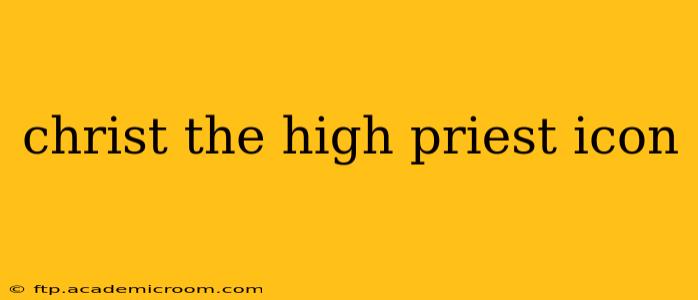The icon of Christ the High Priest is a powerful and evocative image within Orthodox Christianity, representing Jesus not just as a king or savior, but as the ultimate mediator between God and humanity. This depiction goes beyond a simple portrait, delving into the profound theological significance of Christ's role as the High Priest of the New Covenant. Understanding the icon's symbolism requires examining its various components and their rich historical context.
What does the icon of Christ the High Priest depict?
The icon typically portrays Christ in priestly vestments, often adorned with intricate detail. These garments aren't simply decorative; they carry symbolic weight, referencing the Old Testament priesthood and foreshadowing Christ's ultimate sacrifice. Common features include:
- The Epitrachelion: This stole-like garment draped across the chest signifies Christ's authority and priestly office.
- The Phelonion: A chasuble or vestment resembling a liturgical robe, representing Christ's kingship and priestly role. Its color often varies, reflecting the liturgical season or specific aspect of Christ's ministry being emphasized.
- The Omophorion: A long, broad stole worn over the shoulders, symbolizing the shepherd's care for his flock. It represents Christ carrying the burdens of humanity.
- The Gospel Book: Often held in Christ's hands, it symbolizes the Word of God, which he embodies and proclaims.
- Gestures and Expressions: The icon may depict Christ in various gestures, from blessing to teaching, reflecting the diverse aspects of his priestly ministry. The expression is often serene yet authoritative, conveying both compassion and divine majesty.
What is the significance of Christ the High Priest icon?
The icon's significance lies in its portrayal of Christ fulfilling the prophecies and expectations of the Old Testament priesthood. Unlike the Levitical priests, whose ministry was limited and imperfect, Christ's priesthood is eternal and perfect. His sacrifice on the cross, represented symbolically in the iconography, atones for the sins of humanity, offering a pathway to reconciliation with God.
How does the icon differ from other depictions of Christ?
While other icons depict Christ as the King, the Teacher, or the Pantocrator (Almighty), the High Priest icon focuses specifically on his mediating role between God and humanity. This emphasis highlights his sacrifice as the ultimate act of priestly service, surpassing all previous priestly ministries. Other icons might show majesty, while this icon emphasizes Christ's service and humility.
What are the theological implications of this icon?
The icon of Christ the High Priest has profound theological implications. It underscores several key beliefs:
- The New Covenant: Christ established a new covenant with humanity, surpassing the Old Covenant mediated by the Levitical priests.
- Eternal Priesthood: Unlike the Levitical priesthood, which was hereditary and passed down through lineage, Christ's priesthood is eternal and unchanging.
- Sacrifice and Atonement: The icon powerfully visualizes Christ's sacrifice as the ultimate atonement for humanity's sins.
- Mediation and Intercession: Christ's role as High Priest emphasizes his ongoing intercession on behalf of humanity before God.
Why is this icon important for Orthodox Christians?
The icon serves as a powerful visual reminder of Christ's central role in salvation. It's a focal point for prayer and contemplation, deepening the understanding of Christ's priestly ministry and its implications for Christian life. It's a constant visual affirmation of hope and reconciliation through Christ's sacrifice.
This icon, therefore, is not just a beautiful work of art but a profound theological statement, enriching our understanding and faith. Its enduring appeal lies in its ability to convey complex theological concepts through a visually arresting and spiritually moving representation of Jesus Christ.
